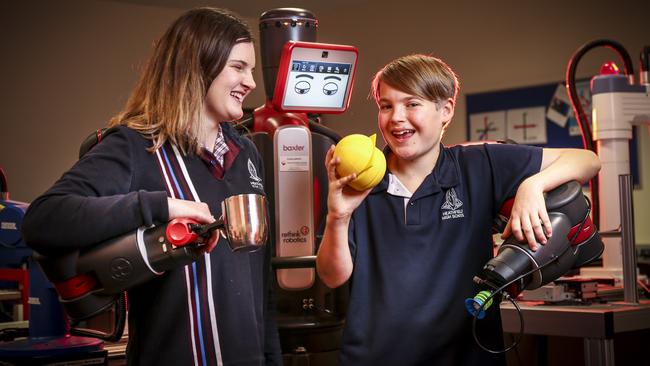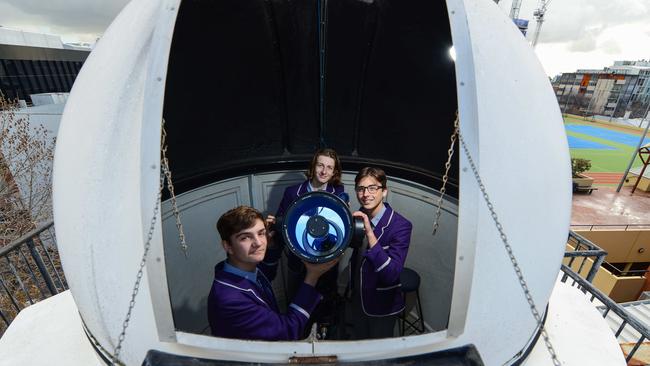Future Adelaide: Schools of 2050 expected to have ubiquitous technology but no year levels
STUDENTS communicate with devices embedded in clothing or accessories, parents monitor their children via live video and teachers work with robots to provide personalised learning programs. Welcome to the world of schooling, circa 2050.
STUDENTS communicate with devices embedded in clothing or accessories, parents monitor their children via live video and teachers work with robots to provide personalised learning programs.
Welcome to the world of schooling, circa 2050. It’s a world where students go on virtual field trips without leaving the classroom — if “classroom” is even the right word.
The continual evolution of technology and communication will give teachers the option of uploading lesson notes and videos to be accessed from anywhere, but still allow students to work together when needed.
Students and classes are unlikely to be grouped in ages or year levels, 3D printing will play a critical factor, robots will be commonplace but artificial intelligence will not take over.
It’s a system far removed from the present day, but one towards which educators have already started working.
The latest Gonski report into achieving excellence in Australian schools identified that our education system would need to adapt to a world with automation. Author David Gonski said school leavers would need skills such as problem solving and communication, as well as critical and creative thinking, that can’t be bettered by machines.
Many educators agree a wave of technological advances means student learning will evolve and change and some schools have already stopped using year levels, started using robots and changed school infrastructure by removing classroom walls.

Students are accessing and posting assignments online, taking part in online group assignments and conducting mock court trials with overseas students.
Futurist Kristin Alford, director of UniSA’s Museum of Discovery, says advances in automation will release teachers from repetitive tasks such as analysing test results, and possibly remove the need for standardised tests such as NAPLAN.
She says the traditional paths of going to school and then to university or TAFE will be blurred and entry into some courses, such as medicine, will be based on the skill set the student has achieved through their personalised learning plans, rather than an ATAR.
“Those hard boundaries that we’ve had — where you finish Year 12 and then go into an undergraduate degree at university — will become a lot more blurred,’’ she says.
“We will see young people taking higher courses through their schooling. We’ll see people taking more school subjects later as they develop competencies. We’ll see people doing a mixture of apprentice-based or TAFE-based courses alongside theories from university to get more combined skill sets, especially in industries such as defence.’’
Dr Alford rejects theories that teachers will be replaced by robots, and says they will be much more involved with their students than they are now.
“There are some things that technology does really well but the best learning is facilitated by a teacher, face-to-face, in a learning environment,’’ she says. “But if you look at what people do really well versus what machines do well — (these include things like) teaching, guiding, role modelling, showing links that are unusual and showing compassion.”
Dr Alford is among a growing number of experts who believe our “industrial” model of achieving outcomes according to year levels is outdated.
NSW-based expert Greg Whitby says schools of the future will focus on students following their interests with project-based learning opportunities, rather than a teacher delivering lessons in a traditional classroom.
“We are likely to have a colony on the moon or Mars which will further stretch our understanding of what young people need to know and how they need to know,’’ Mr Whitby, executive director of schools in the Catholic Diocese of Parramatta,says.
“Artificial intelligence will continue to take the low-order skills out of the learning and teaching process and will provide detailed analytics on student progress.
“Communication devices will be more embedded in clothing and accessories. Projection onto walls and other objects will be the norm and video or FaceTime will be as important as real time.
“Robots and machines will be working closely together, they will not be taking over.’’
Playford International College principal Rob Knight says global trends show more and more students learn through a suite of software programs.
The school is now transforming to a more modern, individual approach. Students still complete 18 lessons a week but are also given opportunities for individualised learning in areas such as one-on-one study sessions, personal training and “masterclasses” in subjects such as cooking.
“At the moment we’ve got 30 per cent of our learning week devoted towards teachers and students having complete freedom and control of what they do and when they decide do it,’’ Mr Knight said.
Baxter cracks the code for fun in the classroom
A ROBOT originally designed for a life of monotonous factory tasks is instead helping prepare Heathfield High students for a hi-tech future.
Baxter the humanoid robot is part of the school’s Year 8 advanced technology program.
Four years ago, the school invested $50,000 in the robot and it now has a big role in the school’s Science, Technology, Engineering and Maths program where for students learn key skills in robotics and ethical issues.
Teacher Ben Evans said bringing Baxter into classrooms allowed the school to meet the digital curriculum requirements of the Australian curriculum while also catering for a range of learning needs.
“Baxter was away of introducing coding to every student in Year 8 but you could have multiple entry levels,’’ Mr Evans said.
“So you could have students that had additional learning needs coding a robot but you could also have students who already had a thorough understanding of coding as a high-end level learner still getting Baxter to do some advanced robotics movements.’’

Baxter industrial robots, introduced in 2011, perform production-line tasks, but the research and education version allows users to teach the robot new tasks.
The robot is an ideal base for computer science, artificial intelligence, human-robot interaction, control, recognition and manipulation of objects.
Students are enthusiastic about learning how to use coding to get Baxter to solve problems.
One area of study is how a robot can help the disabled, such as amputees.
Students use coding to direct Baxter to pick up kitchen utensils, pour a cup of coffee or do something around the home that would benefit the person with the disability.
“He’s a great entry level to some of the other robotic programs we do at the school,’’ Mr Evans said.
“It would be a rare find for school to have someone like Baxter.
“Anything that takes a couple of movements to do — that’s the sort of things he can do.’’
As part of the semester program students also brainstorm how robots will help humans in the future and discuss the ethics around robots and society. Ava Roach, 14, was very excited at her first glance of Baxter in the classroom and she believes that robots will help humans in the next few decades.
“I think that robots will be able to help humans in the year 2050 with complex tasks such as automated tasks including factory work,’’ she said.
“I believe they will be able to assist people with many jobs, but I don’t believe they will take over all jobs that need constant human interaction. They may be there to help humans when absolutely necessary.’’

Boys star gazing to a brighter future
A STATE-of-the-art observatory and flexible learning spaces will be key features of a new centre of innovation and learning at Christian Brothers College.
Principal Noel Mifsud says the school has taken steps to prepare a different type of student for the demands of the future workforce.
Mr Mifsud says students will need to be problem solvers as they move from job to job.
He says educators of the future will have the difficult task of delivering an education to students that will cater to the requirements of a rapidly changing workforce.
“How do you prepare children for that?’’ Mr Mifsud said.
“We’ve moved from teacher delivery up the front of the classroom to a system that’s far more fluid and flexible.”
